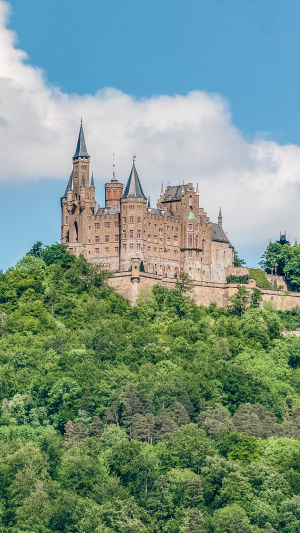Germany stands as a country steeped in historical heritage and cultural richness.
Its journey through time is akin to a magnificent epic woven with tales of triumphs and transformations.
Amidst the annals of German history, one monumental edifice emerges, carrying within its walls countless narratives and serving as a silent witness to the nation's ascent and splendor – Hohenzollern Castle.
<h3>A Magnificent Stronghold</h3>
In Baden-Württemberg, in southwestern Germany, Hohenzollern Castle perches atop a hill, commanding a breathtaking view of the Rhine Valley from its elevation of 855 meters above sea level.
Erected in the early 11th century, this castle stands as one of Germany's oldest and most magnificent, blending elements of Romanesque, Gothic, and Renaissance architecture to epitomize the grandeur and sophistication of medieval European building design.
<h3>A Symbol of Imperial Majesty</h3>
Throughout the annals of history, Hohenzollern Castle has assumed a pivotal role, evolving into a symbolic bastion of the German royal lineage. In the early 12th century, the House of Hohenstaufen established the Hohenstaufen Empire, with Hohenzollern Castle serving as its political epicenter and noble abode.
As the Hohenstaufen Empire ascended, laying the foundation for the German Empire, Hohenzollern Castle emerged as the emblem of this burgeoning imperial force.
<h3>Radiance of the Holy Roman Empire</h3>
During the Holy Roman Empire, Hohenzollern Castle stood as a sanctuary for emperors and nobles, hosting splendid banquets and pivotal political summits. Within its walls, momentous decisions were made, and historical events unfolded, shaping the trajectory of Germany and Europe.
<h3>Confronting the Challenges of Modernity</h3>
However, as epochs transitioned, Hohenzollern Castle confronted its share of trials. Amidst the turmoil of the Thirty Years in the 17th century, the castle weathered numerous assaults, facing near destruction during a Swedish siege in 1632.
Yet, despite the onslaught, the castle's resilient architecture endured, embodying the indomitable spirit of the German populace.
<h3>A Cultural Renaissance</h3>
With the onset of modernization, Hohenzollern Castle transcended its role as a mere symbol of political power, metamorphosing into a cornerstone of cultural heritage.
In the early 20th century, extensive restoration efforts revitalized the castle, restoring its former glory. Today, Hohenzollern Castle stands as a premier tourist destination in Baden-Württemberg, captivating visitors from across the globe.
<h3>Conclusion</h3>
Hohenzollern Castle is a sentinel of German history, witnessing the nation's journey from the Middle Ages to the modern era. Beyond its architectural magnificence, the castle embodies the essence of the German national spirit and cultural legacy.
Standing atop the ramparts of Hohenzollern Castle, one is imbued with a profound sense of the depth and grandeur of German history. Forever enshrined in the hearts of the German people, this castle holds a place of unparalleled significance.





